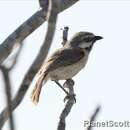Biology
(
англиски
)
добавил Arkive
Often found in small groups, the red-shouldered vanga searches for food in low, dense bushes, two to three metres off the ground, where it plucks its small insect prey from leaves and branches (2) (4). Vangas generally build deep, bowl-shaped nests (3).
Conservation
(
англиски
)
добавил Arkive
The red-shouldered vanga occurs within one protected area: the Tsimanampetsotsa Strict Reserve. Another region within its range has been identified as a site of special biodiversity interest and warrants formal protection (4). This protection, along with further research into the species, has been recommended by BirdLife International to ensure this species' conservation status does not worsen (4).
Description
(
англиски
)
добавил Arkive
This small bird was first described to science as recently as 1997 (1). It is named for the brick-red feathers on the 'shoulders', which contrast with the grey back and dark grey wings. The underparts have whitish plumage, with a wash of chestnut over the breast and flanks (2). A black patch sits like a bib at the top of the breast and extends up over the sides of the neck, contrasting with the white face. Female red-shouldered vangas differ slightly from this description, having olive-grey-brown upperparts, a whitish throat, and buff to whitish underparts. The eyes are pale lemon yellow, the bill is black and the legs and feet are pinkish-grey (2). Vangas generally have an elaborate and melodic vocal repertoire (3); this species song is a loud 'tyu-tee' (4).
Habitat
(
англиски
)
добавил Arkive
This species is found in dense scrub dominated by Euphorbia species (a diverse group of succulent plants) (4), at altitudes around 100 metres (2).
Range
(
англиски
)
добавил Arkive
The red-shouldered vanga is endemic to Madagascar where, to date, it has been recorded from several locations in the south-west of the island (4).
Status
(
англиски
)
добавил Arkive
Classified as Vulnerable (VU) by the IUCN Red List 2007 (1).
Threats
(
англиски
)
добавил Arkive
While in some areas the habitat of the red-shouldered vanga is being degraded by goat grazing, shrub clearance for charcoal, and timber extraction, the majority of the habitat remains intact as the soil is unsuitable for agriculture. However, as the red-shouldered vanga is known only from a small area, its status could deteriorate rapidly should this situation change (4).
Red-shouldered vanga
(
англиски
)
добавил wikipedia EN
The red-shouldered vanga (Calicalicus rufocarpalis) is a member of the vanga family endemic to south-west Madagascar.[1]
This species is notable for being the last species viewed by internationally renowned bird watcher Phoebe Snetsinger before her 1999 death in Madagascar.[2]
Description
Like many of the vangas, this species is sexually dimorphic; the male is the more colorful of the two. He has a pale gray crown, nape and mantle, with white on the ear coverts and forehead. Other than a black bib, which extends from the beak partway down the breast and up the sides of his neck, his underparts are principally whitish, tinged with pink on the breast and flanks. His flight feathers are brown, his wing coverts are brick-red, and his tail is a pale brick-red. His beak is black, his irides are yellow, and his legs and feet are pinkish-gray.[3]
Conservation and threats
The species has been rated as Vulnerable by the IUCN, based on its low population numbers and very small range.[1]
References

- лиценца
- cc-by-sa-3.0
- авторски права
- Wikipedia authors and editors
Red-shouldered vanga: Brief Summary
(
англиски
)
добавил wikipedia EN
The red-shouldered vanga (Calicalicus rufocarpalis) is a member of the vanga family endemic to south-west Madagascar.
This species is notable for being the last species viewed by internationally renowned bird watcher Phoebe Snetsinger before her 1999 death in Madagascar.
- лиценца
- cc-by-sa-3.0
- авторски права
- Wikipedia authors and editors

